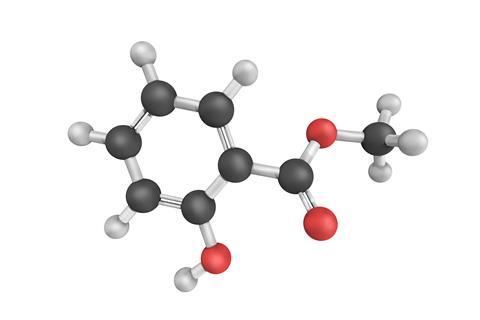Meera Senthilingam:
This week, we get burning cold as Raychelle Burks gets our senses going.
Raychelle Burks:
It smells minty cool, feels warm on our skin, and has been used in food production, sports medicine, cosmetics, intimate products, and fashion.
Methyl salicylate. Better known as ‘oil of wintergreen’.

That nickname comes from a big plant source of methyl salicylate – wintergreen plants. Easily distilled from plant leaves, oil of wintergreen is 96-99% methyl salicylate and very pungent. Besides smelling minty, methyl salicylate also tastes minty, but wintergreens aren’t mints. Wintergreen plants are members of the genus Gaultheria, while mint plants like peppermint and spearmint, are of the genus Mentha.
The shared minty scents of mint and wintergreen plants, along with their oils, are often described as ‘cooling’. To the touch, we perceive mint topical products as cooling – often not so for those containing oil of wintergreen. The difference comes down to chemistry and ion channels.
Mint’s chief sensory molecule is menthol, a molecule that activates a transient receptor potential (TRP) ion channel called TRPM8. This channel plays a key role in our cold response.
Wintergreen’s methyl salicylate activates another channel called TRPA1, which triggers our burning cold response – emphasis on burning. Research indicates that methyl salicylate also trips heat channel TRPV1, the same channel that chilli pepper’s hot chemical culprit capsaicin provokes.
Burning cold, heat … these sensations can all work together so that when we apply methyl salicylate containing creams, lotions, or ointments we feel a warming sensation. Numbing might follow depending on the concentration of methyl salicylate is applied. Methyl salicylate is a topical analgesic, as is capsaicin and menthol.
What if we combine menthol and methyl salicylate? Already done and very popular! Think of muscle rubs like Deep Heat and IcyHot – cooling and warming, both popular in treating aches and pains. Personal lubricant maker KY combine cooling and warming with their product KY YOURS + MINE, which contains menthol-like cooling chemical called menthyl lactate and methyl salicylate.

These methyl salicylate products don’t just benefit from the warm feeling this chemical can spawn, that minty scent and flavour can also come through.
As a flavour and fragrance agent, methyl salicylate is a top pick. Shampoo, toothpaste, chewing gum, candy, jeans…
Jeans?! Yes. Naked and Famous Denim introduced minty new sratch-n-sniff jeans, which owe their smell to methyl salicylate encased in polymer microcapsules.
Considering all the products that contain methyl salicylate, that would mean a LOT of wintergreen is steam distilled. That’s probably true, but tons of methyl salicylate is whipped up in industrial labs through an esterification of salicylic acid and methanol.
We use methyl salicylate to feel, flavour, and fragrance. Why do some plants – such as wintergreens – make it? Defense.
Research has shown that methyl salicylate is part of a plants’ arsenal in the battle against pathogens and herbivores.
That sounds a lot tougher than our most popular uses of methyl salicylate. Of course, we could think of our uses as a defence too – at least against bad breath and sore muscles.
Meera Senthilingam:
Science writer Raychelle Burks, putting her defences up with the chemistry of methy salicylate. Now next week, a murder mystery:
Matthew Gunther:
Following breakfast, Alex decided to put on his running gear and go out for a jog on a very brisk November morning. He would never come back.
Meera Senthilingam:
Matt Gunther reveals why in next week’s Chemistry in its Element. Until then, thank you for listening; I’m Meera Senthilingam.













No comments yet